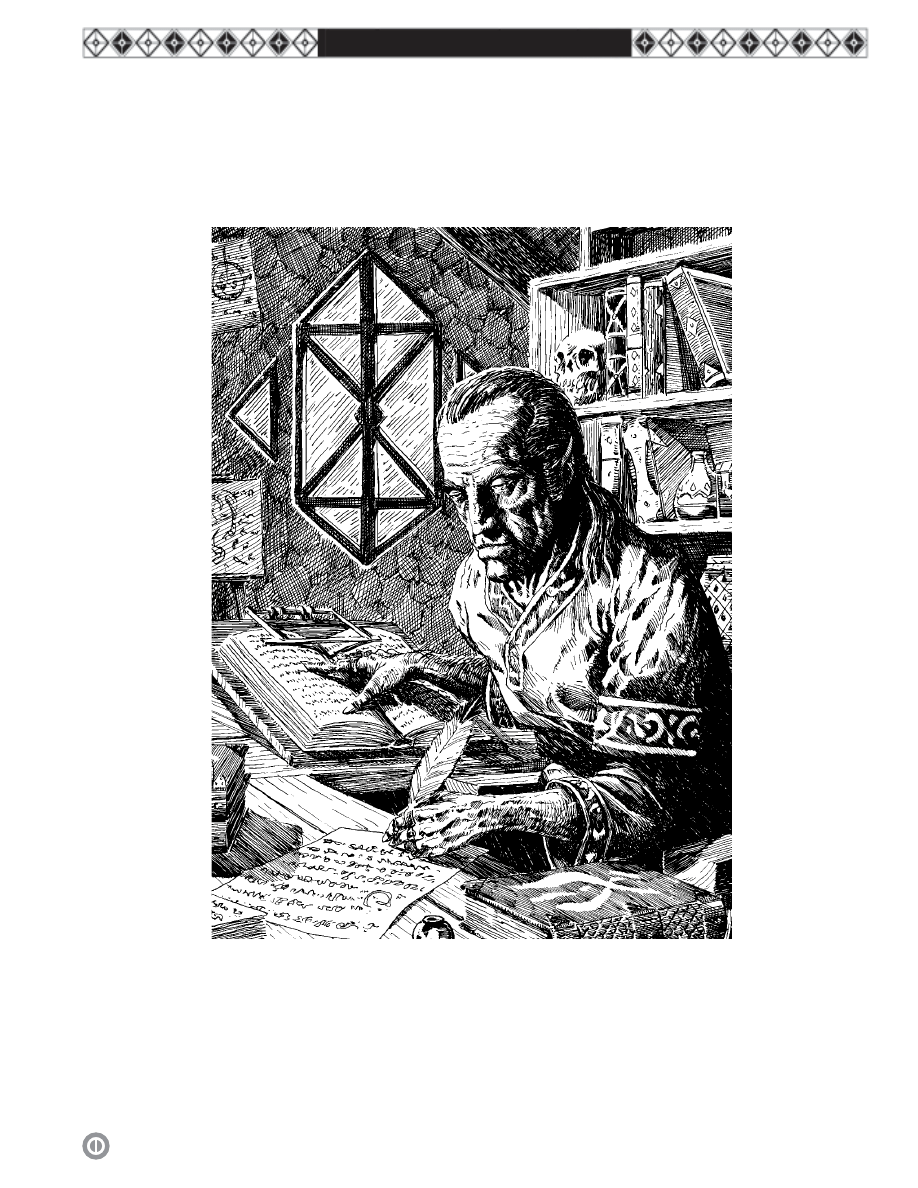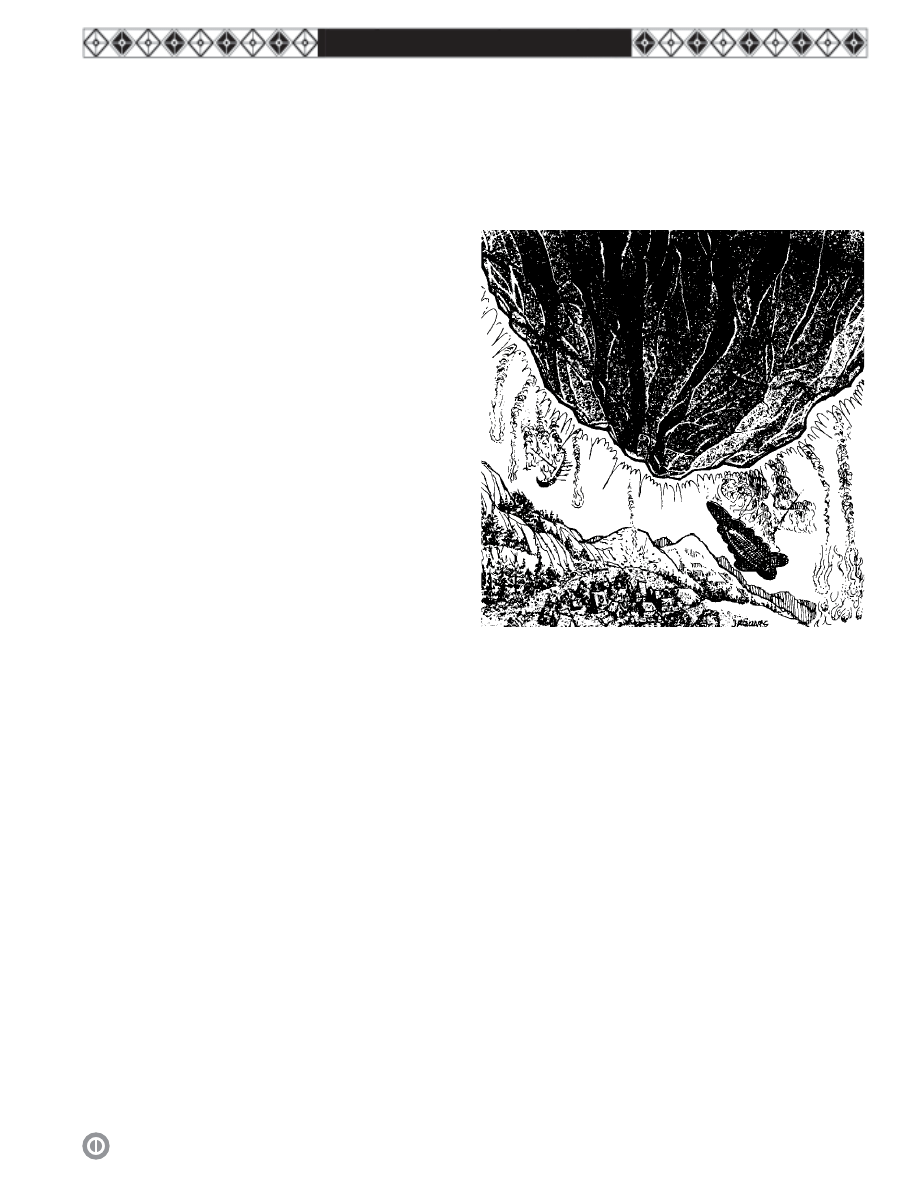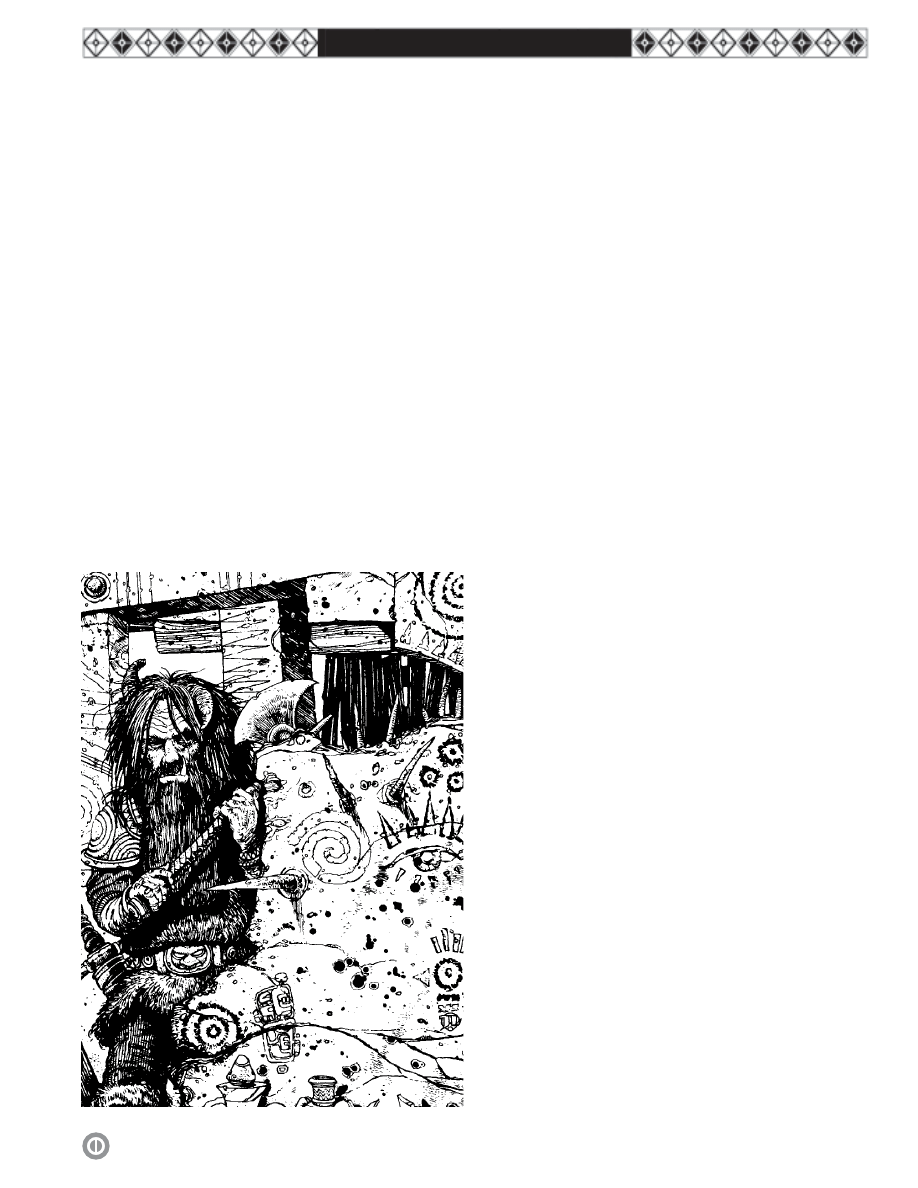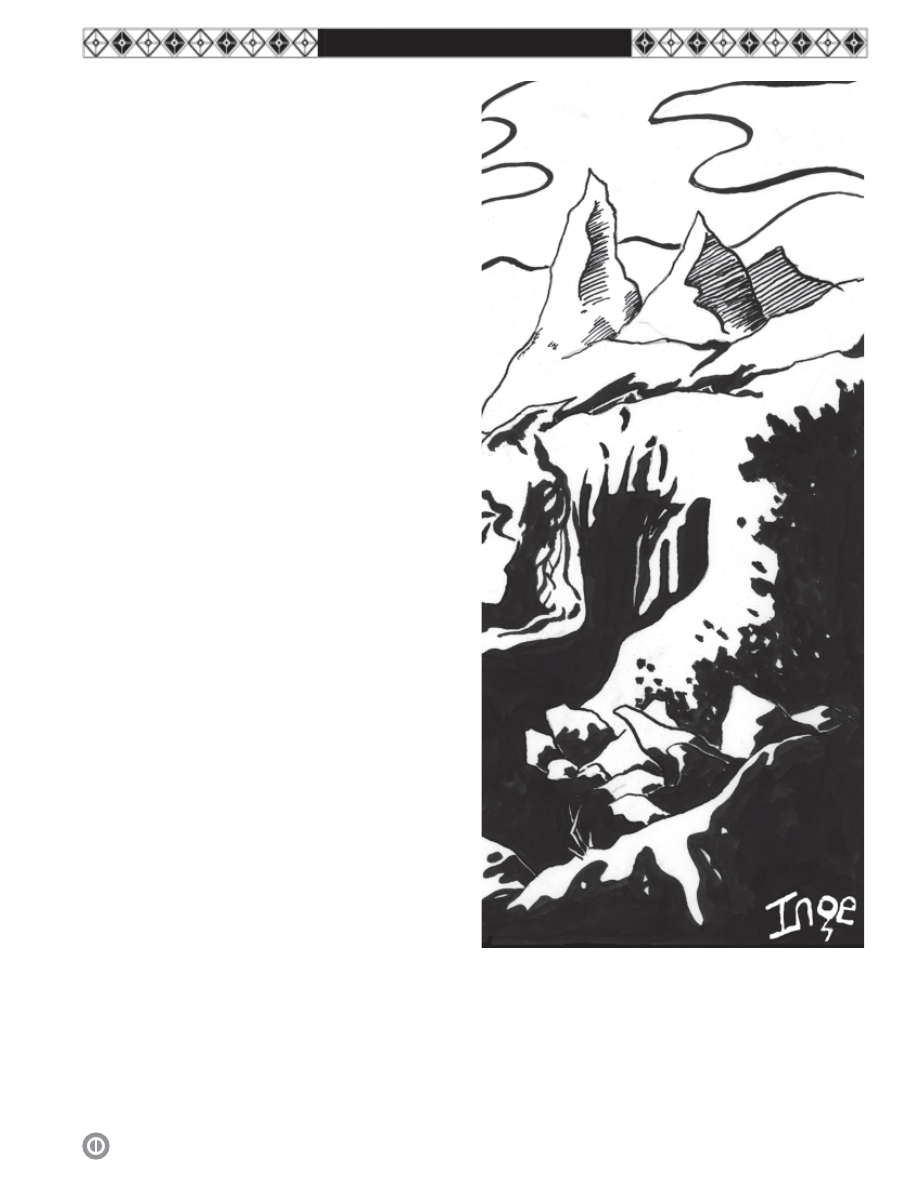
EARTHDAWN
1
HOW IT CAME TO PASS
Though we must be thankful for the here and the now, we must always remember what was.
Some things must never be allowed to happen again.
— King Varulus of Throal, 1438 TH
EARTHDAWN

EARTHDAWN
HOW IT CAME TO PASS
2
[The following is abridged from the opening lecture by the
ork Troubadour Storymaster Jallo Redbeard to a new class of
dwarf scholar students in the great library of Throal, 1512 TH.]
Regardless of what one believes of the Therans, the story of the
lands we now call Barsaive would not be complete unless we started
with them. Without the Therans, Barsaive might have ended up as
nothing more than the scores of warring tribes and city-states that
dotted the land a thousand years ago. Though the Therans brought us
oppression, deceit, slavery, and inhumanity, they also gave us culture,
politics, commerce, and a glimpse of the power that unity can bring.
What we know of the origins of the Therans comes from their
mouths and their writings. It is their tale, their legend, that we recount
here. How much is truth, how much is lie, and how much falls between
may never be known while the halls of Thera still stand. Despite that,
it is a tale worth telling, the story of the creation of an empire.
THE MARTYR SCHOLAR
The saga of Thera begins nearly one century before the founding
of the dwarf kingdom of Throal.
The elf Elianar Messias, who will one day be revered or cursed as
the Father of Thera and the Martyr Scholar, is an honored follower of
the elf Spiritual Path. In addition, Messias is an important advisor to
High Queen Failla of the Elven Court at Wyrm Wood, the center of elf
culture. Messias has a falling-out with Failla over the desire of the elf
nation of Shosara to loosen the cultural shackles that bind it to the
Court. Messias believes the elves of Shosara should be allowed to develop
their national culture as they see fit. Failla disagrees: the Court is the
center of elf culture and all elf nations must emulate her. Failla will
allow no exception.
Failla declares Shosara “separated” from the Elven Court, an act of
such gravity that it threatens to fracture that nation. Messias adamantly
opposes Failla and her Declaration of Separation and is banished for his
challenge. Queen Failla casts him from the Court for one hundred
years, and orders that he may return after that period only if he “has
learned the value of heritage and a quiet tongue.” Messias never returns.
As part of his banishment, he is dispatched to a small monastery
set in the foothills of what are known today as the Delaris Mountains,
in southeastern Barsaive. There, along with a cadre of scholars dedicated
to Mynbruje, the Passion of Knowledge, Messias works to recover,
translate, and transcribe volumes of books and scrolls recently recovered
from a nearby mountain cavern. The scholars believe this cache of
knowledge to be thousands upon thousands of years old, dating from
early in the time when the magical aura of our world still lay dormant,
before it rose to become the vibrant energy of our own time. What little
learned men had deciphered of the works prior to Messias’ arrival
indicated that the documents spoke of an even older time, when the
world’s aura was as strong as it is now.
Messias focuses on a group of six books barely kept intact by the
magic and climate of the cavern where they are stored. The six are a set,
matched in size and style, even down to the odd, blood-inscribed rune
on each of their covers. Messias can tell just by looking at them that
they contain powerful, probably dangerous, information. He also
believes them to be a warning, though against what, he does not know.
He devotes his life to untangling their secrets. In the end, those secrets
eagerly take the life he has offered.
Late one evening, some years later, his fellows discover his body
twisted and wracked with his dying agonies. Messias has torn his eyes
from his head and then thrust his clenched fists and their bloody
contents into the fire raging in the hearth of his quarters. He has also
left a brief note nearby. It says:
These are the Books of Harrow.
They are our doom and our salvation.
Learn from them, or we will all perish.
That night, something horrid stalks the corridors of the monastery,
and six of Messias’ brethren die terribly. The next morning, an elder
elven scholar named Kearos Navarim takes the six Books of Harrow,
three of his fellow scholars, and ample provisions, and sets out on a
long journey to the land of his birth far to the south and west of
Barsaive. In that place, in the protection that he knows he can find
there, he intends to continue Messias’ work and unlock the secrets of
the Books of Harrow. He and the others settle on an island in the midst
of the great Selestrean Sea and found a place of learning called
Nehr’esham, or “Center of the Mind.”
This place marks the beginning of Thera, the beginning of the
learning that would reveal the Horrors to us, and the beginning of the
great war of the mind to save us all.
THE ETERNAL LIBRARY
Word of Nehr’esham and of its Great Project to translate the
Books of Harrow spreads quickly throughout the lands of the world.
The island soon becomes a gathering point for magicians, Adepts, and
scholars of all types and races. Nehr’esham grows rapidly from its humble
beginnings into a small city. Though Navarim nominally leads the
burgeoning city, he keeps around him a tight circle of scholarly and
magical advisors who administer to the city’s needs. Navarim himself
concentrates on unlocking the secrets of the Books of Harrow.
Realizing that more books like the Books of Harrow must have
survived elsewhere, Navarim sends scholars and Adepts out from the
island to find these books and bring them back to Nehr’esham. To
hold these tomes and scrolls, the city’s overseers arrange for the
construction of what will become known as the Eternal Library.
Magically protected and controlled, it will be a place where these and
other ancient works can be kept and studied in safety, for both the
works and the reader.
Ironically, as the first stones for the Eternal Library are laid,
thousands of miles to the northeast, dwarf miners are taking up
permanent residence in the giant mines and caverns that will someday
compose Thera’s greatest rival; the dwarf kingdom of Throal. The Throal
Calendar, by which Barsaive will one day mark its time, counts forward
from that day.
THE FIRST HORRORS
As the Eternal Library nears completion, one hundred and fifty
years after the founding of Nehr’esham, the first signs of the Horrors
begin to appear in the world. In the city of Majallan, in the human-
dominated lands of Landis, dark wraith-like spirits stalk the streets,
driving men to violence against each other. For a year, in the city of
Draoglin, in the ancient dwarf kingdom of Scytha, every dwarf child

EARTHDAWN
HOW IT CAME TO PASS
3
shrivels and dies before reaching its first month of life, its essence
devoured by something unseen. And across the entire land that will
one day be Barsaive, hordes of twisted, insect-like creatures are found
nesting in isolated areas. In southern Barsaive, their infestation is so
great that sworn enemies find themselves working side by side to destroy
the creatures. This time, known as The Burning, is the closest Barsaive
comes to unification prior to the arrival of the Therans. Hopes of unity
collapse, however, in the face of the tragic famine that grips Barsaive in
the following years.
To the aged Navarim and his followers, the dreadful tidings from
Majallan, Scytha, and the city-states of southern Barsaive portend the
beginning of something terrible. What these awful signs warn of
becomes frighteningly clear shortly thereafter. Navarim’s brilliant student
and assistant, the dwarf Jaron, breaks through to understanding and
completes the translation of the first of the six Books of Harrow. This
book, Named simply The First Book of Harrow, speaks of terrible days
ahead, of the coming of the Horrors, their nearly unstoppable power,
and the possible ruination of the world.
The Horrors, the book says, are terrible spirits dwelling in the
darkest corners of the netherworlds. When the magical aura of this
world reaches a certain strength, the Horrors will be able to build
mystical bridges between this world and the twisted realm where they
dwell. And then, the Horrors will come. Terrible and powerful, they
are beyond reason. They seek only to consume. Some desire anything
physical: rocks, trees, it matters not. Others want flesh, blood, and
living creatures. The more powerful live on pain, terror, and the dark
emotions those experiences arouse in their victims.
The Horrors will come, the book says, and little can be done to
stop them.
THERA IS BORN
Word of the First Book of Harrow spreads quickly. The city around
Nehr’esham begins to swell just as quickly, until it covers the entire
island. It is soon renamed Thera, meaning “foundation.” In time, the
island becomes a center of trade and commerce as well as the center of
learning and thought in the eastern Selestrean Sea.
The growth of Thera does not come without its price, however.
Unable to support the enormous tasks of physical labor required to
keep up with the swelling population and commerce, the Therans
must import workers from other lands. Theran slavery begins with
these laborers. The great Theran merchant houses that arrange for the
transport of the workers maintain “control” over the workers they
import. Financial arrangements must be made with the merchant house
for the use of the workers. Soon, “control” of workers becomes
commonplace as the powerful and influential arrange to import workers
specifically as servants and minor laborers. Within seventy years from
the arrival of the first work-ship, “control” becomes ownership, and
true slavery is as common on Thera as the ocean breeze.
Within a year of the translation of the First Book, Navarim
dispatches copies to all the leaders in all the lands he has ever heard of
in an effort to warn them. Few listen.
Meanwhile, work on deciphering the other Books of Harrow
continues in the hopes of finding some way to stop or defend against
the Horrors. Early on, Navarim establishes the School of Shadows as
the center for this effort and charges it to find ways of defeating the
Horrors. From that School, groups of Adepts and magicians travel
across the known world to confront the burgeoning Horrors and learn
what they can from those confrontations.
At the same time, Thera’s leading citizens create a more formal
organization to govern the island. Navarim, named the Elder of Thera,
presides over a body of advisors and administrators known as The
Twelve. This body controls and manages the various areas of Thera and
her growing influence. In one of their first acts, The Twelve establish a
military force to defend Thera against increasing bandit and pirate
raids.
The research conducted at the School of Shadows proves to have
more uses than at first expected. Theran scholars and magicians discover
insights and understandings into the ways and makings of magic that
have far-reaching ancillary results. Their research opens up to the Therans
the ability to work the powerful elemental magic contained in the True
Forms of air, earth, fire, water, and wood. Using that knowledge, the
Therans build their stunning cities, none of which could exist without
the aid of magic. They also create their airships, vessels of all kinds that
fly through the air. Their research also gives them knowledge of magical
warding and protection, illusion and healing, the transformation and
manipulation of physical objects, and insight into the deepest reaches
of the netherworlds. Thera becomes an island, a nation, and eventually
an empire built on magic.
THE THERANS AND BARSAIVE
As Thera grows, the land that will someday become Barsaive exists
in ignorance. Un-Named, the area is home to independent tribes and
isolated city-states. Little trade exists between these powers, the only
real contact coming through intermittent attacks on rich Thera by the
poorer city-states. Occasional efforts by the Elven Court at Wyrm
Wood to bring the area under their control fail. Though rulers of a
great empire, the elves of Wyrm Wood do not see enough worth in
conquering Barsaive to exert the necessary political and military pressure.
Their failure ultimately leaves Barsaive vulnerable to Theran domination.
In the Throal year 212 TH, the Therans finally arrive in Barsaive.
They first make contact with the humans of Landis near the city of
Vivane and what will someday become Sky Point. From there, Theran
representatives and ambassadors travel across Barsaive, making contact
and trade alliances with every group they can find. This land, they
discover, abounds with the natural and magical elements and materials
the Therans covet. The Theran envoys promise a glittering future
through trade to Barsaive’s city-states and tribes; dazzled by the prospect
of Theran riches, the local leaders sign agreements without reading
between the lines.
The arrival of the first Theran trading fleet in 216 TH comes as a
great surprise to Barsaive’s local powers. They had signed treaties and
agreements with the Theran envoys, but without any real understanding
of the implications. The sight of dozens of Theran airships drifting
slowly through the air over their palaces, castles, and tents is a literal
and symbolic blow to them. A new power has come to Barsaive now,
and it is second to none.
BIRTH OF AN EMPIRE
The Therans enjoy their growing power. The island itself, its
central citadel, the Eternal Library, and other great works of architecture
and culture are renowned across the world. Thera’s position in the
heavily traveled Selestrean Sea makes her an ideal port of trade and

EARTHDAWN
HOW IT CAME TO PASS
4
commerce. For mystical thought and pure magical power, Thera has
no equal. The potency of her magicians and the skill of her Adepts are
envied the world over. She needs little else to seal her position in the
world. Nevertheless, Fate gives it to her.
Nearly four hundred years after the founding of Nehr’esham, in
the Throal year 341 TH, Kearos Navarim dies of old age. His body is
sealed in amber and placed in the great plaza of the citadel at the heart
of Thera, next to the cenotaph of his friend Elianar Messias. Word
spreads quickly that Navarim died while putting the finishing touches
on the culmination of the Great Project and the researches of the
School of Shadows. The rumors are correct.
Five years after Navarim’s death, his successor as Elder of Thera,
the human Meach Vara Lingam, announces to the world that though
the scholars have found nothing beyond a keen blade and an iron will
to defeat the coming Horrors, they have discovered something to protect
against them. Lingam unveils to the world Kearos Navarim’s crowning
and final work, the Rites of Protection and Passage.
RITES OF PROTECTION AND
PASSAGE
Despite Lingam’s brave words, the Rites of Protection and Passage
does not offer any truly effective methods of protecting against the
Horrors, but it does present the theoretical means by which that
protection can be discovered. In his four-volume work, Navarim
concluded that isolation from the Horrors is the only true means of
protection against them. Because of their individual power and sheer,
overwhelming numbers, direct confrontation with the Horrors would
ultimately prove suicidal.
To hide from the Horrors, Navarim proposed to construct great
underground fortresses. Dubbed kaers, these dwellings would protect
their occupants against the Horrors on the theory that strong enough
walls will keep out even the most physically powerful Horror. The
natural, solid, earthen walls of the kaer would also provide protection
against those Horrors that travel through astral space or by means as yet
unknown. However, Navarim warned that an earthen barrier might
not be enough to withstand every Horror.
Navarim’s book also offered other means of protection. Cities could
be shielded under domes woven of True Air. Kaers could be built
beneath the sea and protected by True Water, and so on. Navarim
believed that the underground kaer would offer the strongest defense,
though even it might be breached.
To shore up the kaers’ defenses, Navarim offered additional
protections to defend against the Horrors on a primal level. Navarim
believed that magicians could learn to create wards and runes that
would “call” to a Horror through magic. Once the Horror examined
the rune, its mind would become caught in the magical web and
mathematical maze of the rune’s construction. Because a Horror comes
from a place deep in the mystical netherworlds, it must always devote
some degree of concentration to keeping itself in this world. A rune
entrapping its mind would break the Horror’s concentration and force
the thing either to retreat or lose its grasp in this world and be flung
back to the pit from whence it came.
Unfortunately for Thera and her sister lands, only the theory for
these runes and wards exists. Navarim believed they could be devised
and had charged the School of Shadows with their creation just prior
to his death. In the meantime, he recommended that kaers be built
wherever possible in preparation for the day when the infestation of
Horrors would become so overpowering that they would render the
surface of the world all but uninhabitable. This would occur, Navarim
believed, in just over eight hundred years.
The School of Shadows continues to work on mastery of the
runes, intending to make them available to all once their secrets are
unlocked. And unlock them they do, but instead of sharing them,
Thera closely guards the secrets of the runes. Soon, she will use them as
a bargaining tool to extend the Theran sphere of influence.
The immediate reaction to Navarim’s work is mixed. Many dismiss
its conclusions outright, while others look upon it with almost religious
reverence. Most, though, cannot take seriously a threat eight hundred
years in the future. They read Navarim’s words and vow to prepare,
later.
ORICHALCUM WARS
Thera, however, does not wait. The mighty, magic-rich island
needs significant and, perhaps, extravagant protection against the
Horrors. To this end, its leaders begin to collect vast quantities of the
magical metal orichalcum. The Therans begin striking favorable trade
agreements in order to obtain large quantities of the rare material. No
one can guess what manner of protection the Therans wish to build
that requires so much of that metal, but as long as they pay well for it,
no one much cares.
For those who do not know, orichalcum can only occur from the
natural mixing of certain other earthen materials that combine in the
presence of True Earth. Though not a part of orichalcum, True Earth is
always found in the same area as that rare ore. Orichalcum must usually
be mined, but occasionally nodes of it are found close enough to the
surface of the land to be gathered by hand.
Orichalcum trade with Thera proves profitable for the rest of the
world, despite the hue and cry of some deprived local magicians. It is so
profitable that shipments become the target of bandits and raiders.
Sixty years after Thera has begun its extensive importation of orichalcum,
the trolls of the Twilight Peaks, called the crystal raiders, lead their
ramshackle airships in a stunning long-distance raid against Shosaran
orichalcum stores being prepared for shipment overland to Thera.
Other raids quickly follow suit as the crystal raiders hone their skill of
raiding by air.
Rather than band together for protection against the raiders, the
lords and leaders of various lands take the raid as a signal to start their
own plundering. The provinces of Ustrect and Cara Fahd
simultaneously attack Landis; Throal is nearly overrun by marauding
bands of orks; the Elven Court in Wyrm Wood fights Scythan dwarfs
and their human allies in a series of terrible battles. The wars last more
than 40 years. Nations switch sides with a shift of the wind, migratory
tribes become little more than mercenaries, and nobility plot against
and betray their own kin. Only in Shosara and Throal are the rightful
rulers not, even temporarily, deposed. For the first 30 years, orichalcum
and elemental mining and gathering operations are declared off-limits
by unspoken agreement between these two kingdoms; both need the
mines, and neither would profit from their destruction.
THE DEATH OF NATIONS
In this story of the three towering giants that are the Theran
Empire, the Kingdom of Throal, and the Elven Court, often overlooked

EARTHDAWN
HOW IT CAME TO PASS
5
are the fates of those nations that did not survive the ravages of war
amongst Name-givers and the corruption of the Horrors. Their Names
mark places on our great maps to this day: the ork kingdom of Cara
Fahd, located to the south and west of Great Sword Valley; the lowland
troll kingdom of Ustrect, located at the northern base of the Twilight
Peaks; and the human kingdom of Landis, located south of the
Greenheart River, on the western edge of the Death’s Sea. Each has vast
and glorious histories, and we know now that their ends were part of
the beginnings of the Horrors’ work upon our land. The Orichalcum
Wars rage on, as these kingdoms fight the crystal raiders, and the ships
of Throal, but none did they hate more than each other. For much of
the forty year long war Cara Fahd squeezes tribute out of Landis, with
the human kingdom frequently succeeding in breaking free of the ork
yoke. Ustrect wars on both, forging occasional alliances with Landis
when such alliance fitted its needs. Finally, with each of their leaders
(both military and political) succumbing to the influence of Horror-
taint, Cara Fahd and Landis clash in a pyrrhic confrontation. The
Queen of Landis, allied with the forces of Ustrect, captures the area
around a lava field ripe with True Fire. In retaliation, the ork prince and
commander, Cathon Grimeye, unleashes every bound or trapped fire
elemental present in the field. No ork survives, the vanguard of the
Landis army and its monarch are destroyed, Ustrect is crippled, and
the mines are severely damaged. Those few who survive the fight
originate the phrase “scorchers” to describe the terrible destructiveness
of the orks. Cara Fahd does not survive as a nation into the next
generation. Landis stagnates, and Ustrect tries to continue on by allying
with Throal. Their actions set the stage for the final, brutal years of the
war. None survive the Scourge.
THERAN NAVY AND EMPIRE
As long as the flow of orichalcum and other magical elements
remains steady, the Therans care little about the war. As the Orichalcum
Wars rage on, more and more Theran mining vessels sail over Barsaive.
These barges rarely touch down, instead mining and gathering True
Air from the clouds around the highest mountain peaks. Using new
techniques known only to them, the Theran miners are very successful.
That success makes them targets.
The crystal raiders, having set off the Orichalcum Wars, sit back
and watch them rage. Because the furious fighting has halted nearly all
mining in the area, they make only the occasional supply raid. The
Theran air barges, however, offer them a target they cannot resist.
The raiders strike quickly and often, plundering and looting the
air barges. Thera warns that they will not tolerate further interference
with the air mining operations. The Therans begin protecting the air
barges with warships, military airships. At first these ships are vedettes,
air barges expanded and armored for war. The raiders thumb their
noses at the Theran war vessels; they continue attacking the convoys,
using their faster, more maneuverable drakkar airships to escape back to
the Twilight Peaks with their booty.
The Therans then begin protecting the mining convoys with
kilas, sail-less, massive, floating stone citadels built specifically for war.
Despite mounting losses, the raiders step up their attacks. The final
straw for the Therans comes after they lose a massive fleet of air barges,
vedettes, and kilas to the raiders. Sixty days later, the Therans reveal
their true power.
As morning comes, the clan-moots of the crystal raiders awaken to
the sounds of alarm across the Twilight Peaks. Drifting across the great
plain to the southeast of the mountains, not far from Vivane, is the
largest airship anyone has ever conceived of, let alone seen. Devoid of a
true ship’s hull and sail, the vessel Victory is a massive shard of rock the
size of a small city, propelled by raw magic in defiance of the laws of
nature. The Therans call this terrible machine of war a behemoth.
The crystal raiders are astounded by the sight, but swarm to their
airships and move to attack. The Theran airship commander dispatches
a messenger spirit to the raiders, telling them to surrender or be
obliterated. Proud and defiant, the raiders destroy the spirit.
Moving to attack, the raiders encounter a thunderous rain of
weapons fire from the Theran ship. Siege engines, mounted onto the
ship’s stone hull and guided by magic, catapult giant arrows of metal
and wood at the attackers. Bolts of mystic energy lash from the airship
as well, as Theran mages focus their powers against the raiders. The
raiders scatter under the onslaught, straight into the waiting guns of
kilas hidden in the clouds overhead.
The battle continues for hours until the Theran behemoth finally
reaches the edge of the Twilight Peaks. Then, it turns its terrible
destructive power away from the remaining raider airships and directs
it against their homes. The siege engines pound the moot-homes, magics
tear into the raider families who attempt to defend the surface buildings
and caverns, and elementals unleashed from the Theran ship ravage
what little defense remains.
Stunned at the massacre they are witnessing, the raiders surrender.
They are taken prisoner aboard the floating city-ship, to be brought
back to Thera as slaves in chains. The Theran forces burn their airships,
though they do not bother to destroy the few remaining survivors in
the Twilight Peaks. With what will become known as the Battle of Sky
Point, the Therans prove they are a power to be reckoned with. No

EARTHDAWN
HOW IT CAME TO PASS
6
longer content to simply conduct trade and commerce subject to the
whims of local lords, the Therans use Sky Point to show the world what
awaits those foolish enough to interfere with Theran desires and aims.
One hundred days later, in the four hundredth and forty-third
year of Throal, the then-human Elder of Thera, Thom Edro, proclaims
the Theran Empire. Thera declares the lands of Barsaive a Theran
province, promising all those who swear loyalty to her protection from
the ravages of the Orichalcum Wars, as well as first rights to new
enchantments to defend against the Horrors. To enforce their power,
the new Empire places a permanent Theran military presence at Sky
Point and founds the provincial capital of Parlainth in the northwest
corner of the land. Dozens of smaller city-states and kingdoms quickly
submit to Thera. More powerful kingdoms submit more slowly, but
visits from the Theran Navy prove persuasive.
A leading citizen of Thera, the human Kern Fallo, is named the
first Overlord of Barsaive. Though Thera controls the province, Fallo
sees the practical value of local administration and calls upon the dwarfs
of nearby Throal to assist him. Throal, unwillingly allied to Thera out
of need for the Theran enchantments against the Horrors, agrees.
Through this administration, Throal mediates between the
Therans and Barsaive. The dwarfs provide a buffer between the
governments of Barsaive and their Theran overlords, defusing much of
the tension between them. Also through this administration, Throal
spreads and promotes the dwarf tongue as the trading language of
Barsaive. For the first time in its history, citizens of various Barsaive
regions can communicate with relative ease.
JARON AND THE SPHINX
When Thom Edro establishes the Theran Empire, he installs himself
as its First Governor. Many know it is only a matter of time before Edro
secures the backing to proclaim himself Emperor.
Other grumblings surface as well, rumors that Edro is using
unnatural magics to extend his life and those of loyal human and ork
followers. Of course dwarf Adepts had long ago developed life-extending
magics for themselves ... but this is different.
Magic had extended the life of the dwarf scholar-magician Jaron
as well, though it left him less energetic than previously. He fears that
Edro is turning Thera into a mockery of the teachings of Elianar Messias.
Each time Jaron voices his objections, another of his followers vanishes.
He realizes that despite his deciphering of the First Book of Harrow,
the expanding Theran Empire no longer considers him an asset.
The night after the disappearance of Jaron’s closest apprentice, a
great working begins in the open park across the harbor from Thera’s
central citadel. Three Great Form earth elementals tear rock, stone, and
True Earth up from the very foundations of the island and begin to
sculpt them under Jaron’s watchful eye. Theran imperial guardsmen
and magicians rush to the area, but a powerful shield surrounding the
park holds them back. They gape in wonder as a giant stone sphinx
takes form. Its head is sculpted turning downward and seemingly
asleep. As the sphinx is completed just before daybreak, Jaron turns to
address the masses gathered in the park. He speaks to them of the
teachings of the Martyr Scholar and the dreams of Kearos Navarim. He
also speaks of the dangers of power and the dark path he fears Thera is
beginning to walk. He has constructed the sphinx, he tells them, to
watch over Thera and her governors. It will remain in the park as the
guardian of the beliefs of the past and an eternal reminder to the
future. As Jaron falls silent, the shield protecting the park dissolves.
The three earth elementals gather Jaron within themselves and together
the four merge with the sphinx. The crowds rush forward, and the
sphinx slowly opens its stone eyes, which blaze from within with a
blue-white light. The sphinx lifts its head to stare out across the main
harbor directly at the central citadel and the heart of Thera. From that
moment on, it remains in that position.
Theran magicians examine the sphinx’s construction, but its
magical weavings baffle them. None can penetrate it enough to even
glimpse the sphinx’s True Pattern, much less learn enough to gain
power over it. Because they cannot predict what may happen, they
fear trying to manipulate or unmake it.
To this day, the great sphinx sits staring out over the harbor of
Thera as a reminder to all who come and to all who rule there. The
leader of Thera remains the First Governor. None has dared call himself
Emperor.
THERA AND THE DRAGONS
Thera’s domination of the cultures of the Selestrean basin and
neighboring areas is not total. Kingdoms and peoples continue to
search for their own solutions to the problem of the Horrors because
success means greater independence from Thera’s increasingly oppressive
rule. They sponsor eager scholars and brave adventurers to seek out
dragons, for the creatures are known to have survived the last Scourge
(as the invasion of the Horrors has come to be known) remarkably
intact. However, many dragons have no desire to share their secrets,
greatly reducing the population of eager scholars. Some dragons, through
bribery or entreaty, share the method of creating the dragon lair, which
scholars believe protected them. A rare few actually contact kingdoms
on their own, offering to help for their own dragon reasons.
The leaders of Thera see the dragon actions as a challenge to their
power and position. Proposed responses spark fierce debate; Edro has
no desire to antagonize the dragons at a time when Thera should be
using all its power to prepare for the coming Scourge. But the factions
that profit most from the trade in magical elements mount effective
pressure. The Theran Navy organizes strikes against three powerful
and influential great dragons. The first two succeed in killing the target
dragons and destroying their lairs, though the action costs the Therans
one of their mighty stone behemoths for the first time. The third strike,
against the great dragon Icewing, fails. The Therans find only his lair,
largely empty of anything of value and power.
Theran ambassadors pass firmly worded communiques through
discreet channels; they refuse to tolerate dragon interference in Theran
domestic policy. The dragons appear to retreat; Theran merchants and
guild Adepts do a booming business as new orders for Theran protective
enchantments flood in.
Then, one sunset, sailors and dock merchants spot a dragon atop
the head of the sphinx. As the Therans hesitate between staring and
fleeing, the dragon flies off. The next morning twelve citizens are
found dead. Two are provisioners to the navy, one an earth-element
smith, one a clerk to the treasurer, two guild Adepts, one a moneylender,
and five are principal contractors for protective enchantments. Each of
the twelve had agitated for, or profited from, the action against the
dragons. Over the next two weeks, the dragons strike twice more. Two
dozen more leading Therans die. Theran diplomatic channels convey a
second message: Therans are to leave dragons strictly alone. No further

EARTHDAWN
HOW IT CAME TO PASS
7
Theran raids will be planned or executed. The dragons apparently take
the Therans’ message to heart and cease to disclose what they know of
the Horrors and the coming Scourge.
RACE TO THE SHELTERS
As the Scourge draws nearer, the kingdoms and cultures of the
world prepare for the mass invasion of the Horrors. Some build small
underground villages with protective wards woven from the roots of
the plants above. The dwarfs of Throal hollow out most of an entire
mountain, the largest in the kingdom, to build their kaer. Other cities
become fantastic citadels, with handwritten runic phrases carefully
inscribed on every bit of masonry in the city. With each new report of
a Horror, work becomes more frantic, ever more urgent. Fear and panic
result in such a heavy spread of rumors that it becomes difficult to sort
out the truth. Contact between cities, and between kingdoms, becomes
erratic. Some cities become so fearful that they isolate themselves years
before the actual Scourge begins.
Throughout this time, the most reliable communications come
from, or through, Thera. The Theran Empire literally holds together
the fabric of civilization until most of their client states are prepared.
Thera’s demands for slaves greatly increase during this period. Life
is cheap, so the demands are met. Rulers sometimes sell an entire town
into slavery in order to obtain the Runes of Warding to protect two or
three other towns. Throal and Landis balk at the increased demand for
slaves and work furiously to pay Thera’s dear price with raw elements.
THE ELVEN SCHISM
Some nations reject Thera outright. Queen Alachia of Wyrm Wood,
High Queen of the Elves, despises the Therans for their use of slavery
and for their political opposition to her rule. She commands that no
elven nation, and no elf, follow the Theran ways of protection. She
presents an alternative in which elf Elementalists will use wood magics
to weave the living plants of a forest into a kaer. The Horrors, she
believes, will be unable to pass through living wood.
Elven scholars outside Wyrm Wood, and it is said even some
within, are aghast at the proposal. They believe that though the Theran
method is not foolproof, it would provide more effective protection
against the Horrors. These magicians and scholars doubt that any
wooden kaer could possibly withstand the savage physical punishment
the Horrors would inflict upon it.
Alachia, however, stands resolute. She vows that any elf who follows
the Theran way will be forever separated from all of elven culture. This
threat, far from cowing the other elven nations, shatters the great cultural
elven empire Alachia commanded, presumably forever.
Word comes first from the elves of the faraway Northern Kingdoms.
As the elves most distant from the Court at Wyrm Wood, they feel the
least amount of true loyalty to its ways. Though little is known of those
Northern Kingdoms in Barsaive, their rejection of Alachia represents a
severe blow to her power. Before she can react, Alachia receives word
from other elven nations and city-states that they refuse to follow her.
They wish the Court well, but they will not follow Alachia to what
they believe to be certain death.
Queen Alachia, in the end, does not formally declare these nations
separate. Their refusal has bereft the Elven Court of much of its power,
making any such declaration an empty gesture. Instead Alachia chooses
to wait until after the Scourge when her continued existence can prove
her wisdom. At her command, the elves of Wyrm Wood begin the
construction of the wooden kaer that will be their downfall.
THE SCOURGE
Scholars now place the beginning of the Scourge in the one
thousand and eighth year of the Throal Calendar. The Therans count
that date as the year TE 565. Both use the same indicator for the
beginning of the Scourge: the sealing up of Thera. As a center and
focus of magical power, Thera is beset by the Horrors earlier and with
greater severity than the rest of the world. Thera’s last words to her
subject nations are wishes of luck and safety, and an affirmation of her
power. Then, the great Dome of True Air and Fire that surrounds the
island ignites and seals Thera off from the world.
Though some other groups had previously sealed themselves off,
the rest of the world sees the sealing of Thera as the last great sign that
the Scourge is beginning. Horrors appear with increasing frequency
and are becoming more than a match for local militia, constabulary,
and brave adventurers.
Within twenty years of the sealing of Thera, the rising tide of
Horrors cuts off virtually all communication between kingdoms. Even
astral space becomes too polluted to access, and magicians the world
over learn the true benefits of the spell matrices devised by the Therans.
Mindless herds of destructive Horrors roam the land, consuming every
scrap of life they can find. Other, more intelligent Horrors probe existing
defenses, and batter their way through weaker ones. Still others infiltrate
society and slip with the people into their kaers. They wait and reveal
themselves, violently or subtly, after the kaer has been sealed.
THROAL AND PARLAINTH
In Barsaive, the great powers of Throal and Parlainth, the Theran
provincial capital, brace themselves against the Horrors and remain
open and accessible for as long as they can. Both provide shelter for
refugees until the last possible moment. Throal’s kaer, though of Theran
design, includes additional mystical dwarf craftsmanship. Parlainth
intends to use a radical method of isolation; its magicians will cast a
great spell to shift Parlainth from this world to another in the
netherworlds, one out of reach of the Horrors. To further keep the city
safe, part of the spell will reach out across Barsaive and wipe the memory
of Parlainth from the mind of every living person. With no memory of
Parlainth, no one will betray either its existence or its disappearance to
the Horrors. (The tale of Parlainth holds both great deeds and great
tragedy, and is best fully told elsewhere) Ironically, at the last minute,
the Theran Overlord of Barsaive loses faith in the plan that he sponsored
and flees to Throal with his staff. Parlainth seals itself off, disappears,
and leaves the memory of Barsaive for nearly four hundred years.
Supposedly safe in Throal, the Theran Overlord and many of his staff
are killed when a portion of the Throal kaer collapses only a few months
after Throal has sealed itself up.
In the years just before the Scourge, the dwarfs of Throal do not
remain idle. Years of administering Barsaive under Theran domination
have taught them much. They know that during the projected time of
the Scourge, six hundred years, much of society and culture will wither
within the kaers. The Theran plan prepared for every aspect of physical
survival; they provided for magical plant nurturing, air and waste

EARTHDAWN
HOW IT CAME TO PASS
8
recirculation, and breeding cycles. However, the Therans had neglected
the less tangible things.
To this end, the dwarfs created The Book of Tomorrow. In this
book, they set down the history of Barsaive and Thera, the great tales of
the day and others past. They wrote out the dwarf language in its
entirety so that children in the kaers could learn to speak, read, and
write a common tongue. The book told them how to rebuild their
homes and lands once the Horrors had gone. The book told them how
to use arts and crafts as a continuing sign that they were free from the
influence of a Horror, for the dwarfs had learned that a person Horror-
tainted could not create things of art and beauty. And most important,
it told the dwarfs how to tell when the dark days of the Scourge were
over.
Finally, in the year 1050 TH, Throal sealed itself off and prepared
for the worst. Throal’s leaders were virtually certain that some Horrors
had entered the kaer with the refugees and knew that they would soon
reveal themselves. Though the story has been lost to the mists of time,
the strength of the dwarfs enabled them to discover and defeat one
Horror before it could ravage the kaer. The time of the Scourge brought
suffering and hardship, but the people of Throal endured through
their physical strength and will to survive.
During that time, other things change in Throal as well. The
dwarfs as a people, and their friends inside with them, look forward to
the future. Discussions begin about what the world will be like after
the Scourge. In the court of King Varulus II, dwarf common sense links
with imagination to provide a new vision of the world.
Philosophers, soldiers, priests, scholars, craftsmen, and nobles argue
for years until a rough consensus emerges. For the first time, the rights
of an individual are argued and defined. The dwarfs write down these
rights and the logic that bred them in the Council Compact of 1270
TH. This document will serve as a guide to forming the new dwarf
society and that of their neighbors in the years after the Scourge. In
broad terms, it defines individual rights, property rights, and the role
of law. For example, the section on individual rights contains the
following passage:
We have shown that rights to property are a necessary good
for an orderly society. What of the issue of slavery, the ownership of
another person?
Persons can certainly be considered property. But who owns
a person? Our common sense dictates that the spirit born into the
body owns the body. That spirit contains its movement, its
thoughts, its actions. The spirit makes active use of the body it
owns. Our language supports this view — an evil spirit who
inhabits and controls a body is said to have “possessed” the body;
this possession is seen as unnatural. The evil spirit has stolen the
body from its rightful owner.
Slavery removes the control of an individual’s body from its
natural spirit to the slaveowner. This transfer is made without
compensation to the spirit, the true owner of the body. Involuntary
servitude also steals the body. It is a crime.
The Council Compact is a rigorously thought-out statement of
principles. Its goal is to develop a fair, orderly society to aid the conduct
of commerce. The Compact embodies common sense and can serve as
a shared belief among all people. During the time in the kaer, the
Compact circulates among dwarf nobles, who accept it without
reservation. Those who believe in the Compact decide that the world
following the Scourge will be different from the one that had existed
before, and very different from the one the Therans expect.
BLOOD WOOD
In 1262 TH, the wooden kaer of the Elven Court begins to fail.
The loss of protection is slow, but inexorable. Panic strikes within the
kaer as the elves desperately seek alternative means of protection. They
haven’t enough time to construct underground kaers, nor do they have
sufficient reserves of Elemental Air or Earth. Desperation and depression
set in as the Horrors begin to break through. The elves create roving
militia squads to respond quickly to breaks in the kaer barriers, as
Elementalists strive to repair the existing breaks and shore up other
weakening sections.
Then the elves of the Wood make a startling and ultimately
terrifying discovery. Of those Horrors that break through, those most
intelligent, most devious, and most difficult to destroy all but ignore
elves who are already mad or in extreme, constant pain. The advisors to
Queen Alachia are quick to realize that these Horrors need to inflict
madness and pain themselves in order to feed. Existing madness and
pain are not enough for them. A horrible seed begins to grow in the
heart of the Wyrm Wood, a plan for protection so terrible that its
implementation will be as heinous as anything the Horrors themselves
can inflict.
Finally, with the Horrors on the verge of complete penetration of
the elven kaer, the elves enact their desperate plan. Elementalists perform
a twisted blood ritual that forces a physical change upon the surviving
elves of Wyrm Wood. Thorns begin to grow out of their skin, ripping
and tearing, leaving them in constant, excruciating, overpowering pain.
The initial Ritual of the Thorns kills many of the elves in Wyrm Wood,
but those who survive learn to live with the pain and even draw upon
it for strength. For the Horrors, nothing they want remains in Wyrm
Wood. Some of the more bestial Horrors continue to attack and attempt
to break through, but the more diabolical ones who feed on pain and
suffering leave to find their nurture elsewhere. The elves of what has
become the Blood Wood have found a way to survive, but at a terrible
price.
THE TIME OF HIDING
Centuries pass as the people within the kaers and citadels huddle
in fear and gradually learn to cope, all the while longing for the touch
of sunlight and the taste of clean air. The inhabitants of many kaers will
not live to see the sun again. Horrors batter or guile their way into more
kaers than anyone even in their darkest thoughts believed possible.
Whole cities are lost to the Horrors, entire societies and civilizations
gone forever.
In Barsaive, the greatest loss may be the city of Parlainth, though
none would remember her grandeur until many years after the end of
the Scourge. We now know that sometime during the Scourge, Horrors
somehow entered Parlainth. All anyone knows for certain comes from
the tale of J’role, the Honorable Thief, and his companions. By the
time they found the magical Longing Ring, learned its secrets, and
used it to return forgotten Parlainth to this world, all of the city’s
inhabitants were dead or gone. Searchers found few bodies; unknown
Horrors had left the city desolate. In the years following the Scourge,
Parlainth became a center of adventure and danger as brave souls from

EARTHDAWN
HOW IT CAME TO PASS
9
all over Barsaive went there to find her lost treasures and unlock her
dark secrets. But even after the Scourge, terrible things still walk the
streets of Parlainth and hide in her darkest corners, and most of her
secrets remain hidden to this day.
Those kaers that hold copies of the Throal Book of Tomorrow
know the magic ritual that will tell them when they may safely re-enter
the world. Those lacking this ritual must guess and hope. The magic
itself is basic: a simple ball of True Earth is enchanted and placed over
a dish of True Water. The magics of the ritual keep the ball suspended
over the water. As the strength of the world’s magical aura wanes, and
the Horrors are forced to retreat, the ball of True Earth descends until
it finally touches the True Water, and the two mix and neutralize each
other.
All across Barsaive, the people in the kaers watch the ball descend.
Slowly, ever so slowly, it drops toward the water. Finally, in the fourteen
hundred and fifteenth year of the Throal Calendar the ball stops falling,
hanging an inch above the water. Shocked scholars and magicians
watch in wonder and dread. It is too soon, by hundreds of years, for
the Scourge to have abated. And why had the ball stopped? No one
knew the answer then, and no one knows to this day. We only know
that, for some reason, on that day, the mystical aura of our world
stabilized and has remained constant from that point forward.
A few years pass and the people in the kaers begin to believe that
the ball will not descend any further. The doors of the kaers begin to
open into a bright, sunlit world ravaged by the Horrors. Most, though
not all, of the Horrors are gone.
THE RETURN
Throal begins the first, tentative return to the outside world just
prior to the cessation of the ball’s drop. Throal scholars and magicians
believe that the strength of the world’s magical aura may have dropped
enough that most of the more powerful Horrors have already begun to
flee. They doubt the accuracy of the Theran calculations of the
Scourge’s length, believing the Therans to have erred conservatively so
that they might enter the new world first and dominate it.
In 1409 TH, the first scouting party sent outside Throal is
destroyed within hours. Each year after that Throal sends out another
scouting party, none of whom, at first, return. In 1412 TH, the scouting
party led by the female troll Vaare Longfang returns alive and intact.
She reports that the Horrors are still present, but they are fewer and less
active. Throal’s leaders decide to launch a greater expedition to learn
the extent of the Horrors’ ravaging. They outfit an airship, give it
magical protection and an elite crew, and offer Vaare Longfang
command.
THE EARTHDAWN
In 1416 TH, just after the world’s aura has apparently stabilized,
the expedition sets sail in the refitted airship, christened the Earthdawn.
Its mission lasts almost a year. The battle-scarred Earthdawn returns to
Throal with an exhausted but exhilarated crew. Vaare has charted most
of Barsaive and found it predominately free of the Horrors. Those that
remain have retreated into pockets of higher magic where they find it
easier to exist. Few live in the open. A jubilant Throal prepares to
emerge into the world.
In 1418 TH, Vaare again takes command of the Earthdawn, to
begin contacting the nations of Barsaive and inform them that the
worst is over. The mission proceeds slowly, for the people of the kaers
and citadels assume the troll and her crew are some trick of the Horrors.
After one year, only two kaers of the twenty-one visited have opened
their doors. King Varulus III alters Vaare’s mission, and orders her to
take the Earthdawn to the largest kingdoms first.
The ship sails for Landis, but never arrives. Last seen at the Cliff
City of the t’skrang House Syrtis on the Serpent River, it is assumed
that Horrors attacked and destroyed the vessel with all hands on board.
For decades afterward, stories abound of sightings of the haunted hulk
of the Earthdawn sailing through parts of Barsaive, vanishing from
sight shortly after being spotted.
THROAL OPENS
Despite this loss, King Varulus III orders the doors of Throal
opened in the summer of 1420 TH. Patrols and magical surveillance
remain high, to guard against unknown Horrors. No one leaves Throal
for nearly sixteen months. Varulus then issues a proclamation granting
land to those who farm, mine, forest, or otherwise make productive use
of it. A trickle of brave souls turns into a flood of opportunists. Despite
setbacks and encounters with some remaining Horrors, the resettlement
of the Throal Mountains begins.
Over the next few years, merchants organize expeditions to
reestablish trade routes with nearby communities. They find some
kaers whose people refuse to open their doors; at those places, they
leave a small tent camp to wait patiently for the kaer to open. The
traders find other kaers and citadels whose defenses have been breached;

EARTHDAWN
HOW IT CAME TO PASS
10
they mark these as dangerous and to be avoided. Many others open
their doors; the merchants give them copies of the Council Compact
and ask them to join the new world that Throal envisions. As the
merchants make more and more contacts, they expand their efforts
deeper into Barsaive and into the areas held exclusively by humans,
trolls, t’skrang, orks, and other races.
They move quickly, for they know that the Therans will return to
Barsaive as soon as they can.
CONFLICT OF DESTINIES
Thera herself does not move as quickly as feared. Little word
comes to Barsaive concerning the condition of the island or its immediate
resources, but Thera’s unexpected absence leads many to believe that
Thera did not escape the Scourge as unbruised as her leaders had
hoped. The first Theran vessels do not arrive in Barsaive until 1449
TH, fifty years after Thera is believed to have opened herself to the
new world.
The Theran emissaries meet with little welcome. The time of the
Scourge and the few years immediately after have given the people of
Barsaive the opportunity to live free of the Theran yoke, and they like
the taste of freedom. The Theran emissaries, unprepared for anything
but respect and cooperation, threaten Barsaive with violence. In answer,
local Barsaivians burn the three Theran vedettes anchored at Sky Point
and put their crews to the sword.
Theran First Governor Nikodus names Fallan Pavelis as the new
Overlord of Barsaive. He orders Pavelis to re-establish Theran supremacy
in Barsaive, for the Therans believe that the land is still their province.
Pavelis chooses the strong hand over the soft voice. Theran vedettes
conduct slaving runs over isolated villages. Shipborne troops attack
coastal cities and seize “forgotten tribute.” Ork mercenaries in Theran
pay conduct bandit raids against kingdoms that resist Thera. Human
tribal leaders are assassinated and replaced with more amenable rulers.
Besieged, the people of Barsaive turn to Throal for help. The
dwarf kingdom has all but promised rebellion with the Council
Compact; surely the dwarfs will counter the Therans and end the
Empire’s domination.
In Throal, though all believe that the Therans must be stopped,
the dwarfs realize bitterly how little they can do on their own. Throal
has not the strength to defeat a combined force of Theran air and
ground forces, nor does any other single power in Barsaive. Together,
though, the combined will and might of all the peoples of Barsaive
may prevail.
King Varulus III sends messengers and emissaries to the rulers of
Barsaive. Together, his message says, Barsaive must either stand free or
else fall into oppression and slavery. Though his words stir the hearts of
many, the sight of Theran airships attacking and raiding at will stills
their actions.
An act by the Therans themselves finally turns the tide. The First
Governor has learned of the Council Compact, receiving a copy from
Pavelis. Enraged by its contents, Nikodus sends a damning message to
his Overlord of Barsaive. The message tells Pavelis that the dwarf logic
of commerce and ownership outlined in the Compact makes it clear
that every man, woman, and child in Barsaive owes their survival from
the Horrors to Thera and the First Governor, personally. This blood
debt makes all the people of Barsaive the personal slaves of the First
Governor, and his to do with as he wishes. He instructs Pavelis to begin
the systematic destruction of all Barsaive cities not vital to elemental
trade or gathering. The first target will be Throal.
As the First Governor shifts troops to Barsaive, and Pavelis gathers
them into the largest Theran armada ever assembled, Barsaive loyalists
within the Overlord’s palace in Sky Point obtain a copy of the message.
They duplicate it and distribute it across Barsaive. The message raises
anger strong enough to banish fear; the peoples of Barsaive no longer
question that they must and will fight.
His army assembled, Pavelis moves on Throal. Though the dwarf
kingdom is unprepared to fight the kind of war Thera brings to them,
the rest of Barsaive is not. Goaded by such heroes as the human J’role
and the t’skrang Westhrall, Barsaive comes to the aid of Throal. Sky
Raiders duplicate their ancestors’ successes of the Orichalcum Wars and
attack Theran ships. T’skrang riverboats run blockades and intercept
supplies. Ork cavalry and elven bowmen assault supply convoys and
base camps and then vanish into the night. Windling thieves infiltrate
Theran command ships and camps and learn valuable information,
leaving behind nasty magical surprises.
Harassed and battered continuously from all sides, Pavelis takes a
desperate gamble to settle the issue before Nikodus’ patience runs out.
He masses his forces for a frontal assault on Throal, but the hit-and-run
fighters of Barsaive cut down half the armada and destroy its supplies.
Facing disaster, the armada breaks, and the Therans withdraw to Sky
Point.
WAR
Barsaive, after initially repelling the Theran advances, returns to
bickering and infighting for the next sixty years. The Therans retreat to
lick their wounds and plan a greater strategy. Finally sensing the opening
they are looking for, the Therans land the behemoth Triumph near
Lake Ban, effectively disrupting commerce over all of Barsaive. At the
same time, King Varulus III is assassinated and Prince Neden ascends
to the throne. Only after launching an assault against the Theran city-
ship does Neden learn that his father was killed by an assassin from the
ruling family of Iopos, the Denairastas. Although the assault on the
Triumph is a military disaster for Throal, Neden rallies the peoples of
Barsaive for a massive, all-out war effort. Neden’s force, made up of the
Army and Navy of Throal, troops from the elf-queen’s court, dozens
and dozens of ships from the crystal raider tribes, volunteers from all
over Barsaive, and several dragons, assault and capture the Triumph.
Pressing on from this victory, Neden’s army joins with the forces of the
newly reborn ork nation of Cara Fahd and commences an all-out attack
on the fortress of Sky Point.
THE SECOND BATTLE OF SKY
POINT
Although the Theran forces are overextended, trying to hold
together pieces of their crumbling empire, Sky Point is a massive fortress
with dozens of other ships on hand and the nearby Theran city of
Vivane to support it. In an effort to cut off this additional support, the
great dragons of Barsaive enact a ritual to isolate the city of Vivane from
the fortress. Although their ritual accomplishes this, the huge amount
of magical energy attracts the attention of a massive, cloud-like Horror
which attempts to envelop the city. The ritual sealing Vivane off prevents
the Horror from attacking the city, but in the course of the battle,

EARTHDAWN
HOW IT CAME TO PASS
11
Theran mages break through the spell, inadvertently bringing the
Horror down on their own citizens. The battle at Sky Point itself is
devastating. Weapons never before seen in Barsaive are brought to bear
by the Therans. Magical attacks tear into the advancing army of orks,
killing hundreds in a single pass. Barsaivian airships are knocked out of
the sky like they are so many buzzing insects. In the midst of all of this,
a battered galleon appears through the clouds. It is the first confirmed
sighting of the Earthdawn in almost a century. As the Barsaivian troops
rally to this sight, the great dragon Vasdenjas is killed defending the
ship. Realizing that this has bought them a critical reprieve, Captain
Chorak Bonecracker of the living crystal ship Thera’s Bane sets a ramming
course, and the ship collides with a base pillar supporting Sky Point.
Several allied captains, flying captured Theran ships, follow his example.
Sky Point, the glorious symbol of Theran dominion in Barsaive, topples,
destroyed. With the Therans routed and nearly half of his original
army dead, King Neden returns to Throal.
THE NEW WORLD
The world after the Scourge is truly new, in ways the sages and
scholars did not conceive. Our world’s magical aura does not diminish
as all our learning tells us it should, but remains strong. We see this as
proof of our survival; the world goes on holding a steady course into
the future.
The realms of Throal and Thera struggle to survive. In the south
of Barsaive, the crystal raiders build airships for future raids on the
lowlands. Ork scorchers roam the land mounted on their fierce chargers,
finding danger and adventure where they can. Many heed the call to
rebuild their once-great nation. The elves of Blood Wood have survived
the Horrors in their own way, a dark way that has riven their community.
Windlings thrive in the places where nature borders civilization.
T’skrang live along the great Serpent River, trading, and pirating.
Obsidimen roam Barsaive, durable, earthbound beings in demand
anywhere that conflict or danger threaten. Nations arise. New alliances
form. Old wounds heal.
And danger lies just off the trade roads, along with the lure of the
treasure amassed and hidden away by now-forgotten people. The
Horrors have receded, but they still hold fast in the darker parts of the
world. Some wait within conquered citadels, curled upon the sprawling
wealth of the vanquished. Others roam the world, their magic weakened
but still powerful enough to wreak havoc in their paths. The Therans
are gone from our land, and for the first time since the Scourge began,
we are truly free to chose our own destinies.
In this fifteen hundred and twelfth year since the founding of
Throal, the world looks vastly different from the one those founders
saw when they looked south across the plain. Only the brave dare
explore this world. Only the heroes can carve the future from ruins of
the past.
Wyszukiwarka
Podobne podstrony:
Third Eye Blind How s It Going to be
How it used to be
How It Feels to be Colored Me
prob analysis how difficult does it need to be
How to pass a drug test
How To Pass Exams
prob analysis how difficult does it need to be
How To Pass Exams
David Icke 911 How is it possible to mastermind
It's Easy to Earn Money
How and When to Be Your Own Doctor
International Law How it is Implemented and its?fects
Is it Glorious to Die for your Country
„The Blame Game” and how it affects our lives
Cisco CCNA Certification knowledge to pass the exam
It's Easy to Earn Money
How and When to Be Your Own Doctor
The Doom That Came to Sarnath
więcej podobnych podstron